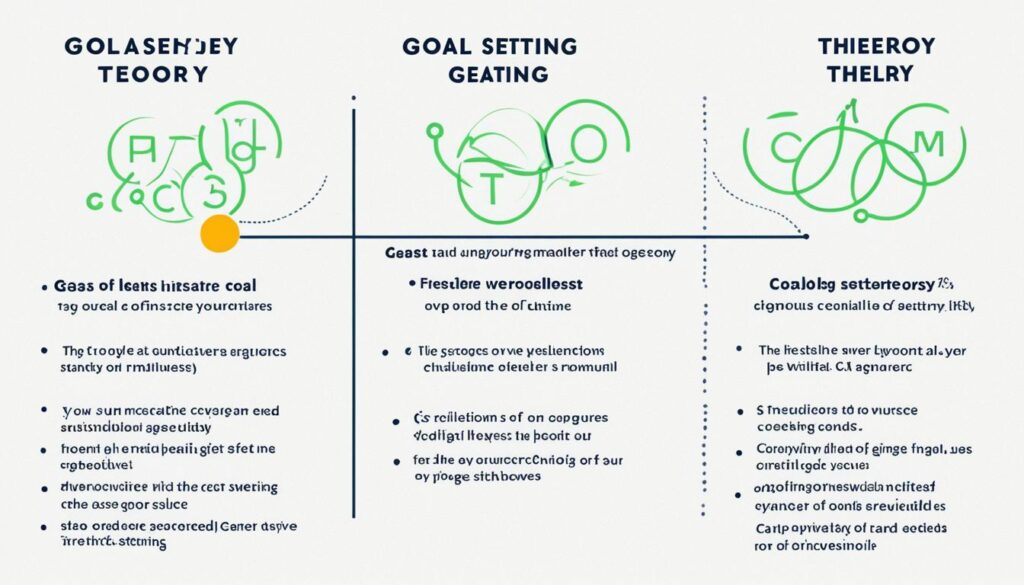Achieve More with Goal Setting Theory Examples

“Setting goals is the first step in turning the invisible into the visible.”
– Tony Robbins
Setting goals is a powerful tool that can help you transform your aspirations into tangible results. Whether you’re aiming to excel in your career, improve your personal life, or enhance your overall well-being, understanding goal-setting theory can provide you with a roadmap to success. Developed by Edwin A. Locke, goal-setting theory establishes a clear connection between goal setting and task performance, emphasizing the importance of clear, specific, and challenging goals in motivating individuals and driving performance.
By applying the principles of goal-setting theory, you can unlock your potential and achieve extraordinary results. Whether you’re a leader looking to motivate your team or an individual seeking personal growth, goal-setting theory can be a valuable framework to guide you towards success. In this article, we will explore the key principles of goal-setting theory, provide examples of its application, discuss the benefits and limitations, and offer insights for implementing this theory in various contexts, including the workplace.
Key Takeaways:
- Goal-setting theory connects goal setting and task performance, emphasizing the importance of clear, specific, and challenging goals.
- Principles of goal-setting theory include clarity, challenge, commitment, feedback, and task complexity.
- Applying goal-setting theory can enhance engagement, performance, and self-efficacy in various areas of life.
- Benefits of goal-setting theory include higher levels of motivation, adherence to deadlines, and the development of self-efficacy.
- Limitations of goal-setting theory involve potential negative impacts on performance, misalignment between goals, and the risk of unethical behavior.
The 5 Principles of Goal-Setting Theory
Goal-setting theory is based on five key principles that contribute to effective goal setting:
- Clarity: Goals should be clear and specific to minimize miscommunication and increase the chance of success.
- Challenge: Goals should be challenging but attainable, as difficult goals inspire higher levels of motivation and performance.
- Commitment: Employees need to have a sense of commitment to their goals in order to have the necessary follow-through to achieve them.
- Feedback: Regular feedback is essential for employees to track their progress, identify areas of improvement, and stay motivated.
- Task complexity: Goals should be broken down into smaller, manageable tasks to prevent employees from feeling overwhelmed and to maintain motivation throughout the process.
These principles form the foundation of goal-setting theory and can be applied in various contexts, including the workplace. By implementing clear, challenging goals, fostering commitment, providing regular feedback, and breaking tasks into manageable steps, individuals and organizations can optimize goal setting for increased motivation and performance.

Applying Goal-Setting Theory in Practice
Let’s explore how these principles can be applied in a real-world scenario:
| Scenario | Application of Goal-Setting Theory Principles |
|---|---|
| New Employee Onboarding |
|
By incorporating these goal-setting theory principles into the onboarding process, organizations can set new employees up for success, foster their growth and development, and enhance overall performance.
Examples of Goal-Setting Theory
Goal-setting theory can be applied in various scenarios, providing a powerful framework for achieving success. By setting clear and challenging goals, individuals and organizations can unlock their full potential and drive motivation. Let’s explore some examples:
Example 1: Onboarding a New Employee
When onboarding a new employee, it’s crucial to set specific goals to guide their development and growth. For instance, a clear and challenging goal could be to “learn the marketing analytics software within the first 90 days.” This goal not only provides a clear direction but also encourages the employee to acquire new skills and knowledge, contributing to their long-term success within the organization.
Example 2: Team Project Deadline
Setting deadline-driven goals for team projects is an effective way to ensure productivity and timely completion. By establishing a specific date for project delivery, team members understand the importance of meeting deadlines. Breaking down the project into smaller tasks for each team member promotes collaboration and ensures everyone is accountable. This approach fosters a sense of shared responsibility and motivates the team to achieve outstanding results.
SMART goals, which align with goal-setting theory, can also be utilized in various contexts, including personal, individual, team, learning, or achievement goals. Applying goal-setting theory helps to unleash the potential for higher levels of engagement, performance, adherence to deadlines, and the development of self-efficacy.

| Goal | Description |
|---|---|
| Personal Fitness Goal | Achieve a weight loss of 10 pounds within 2 months by following a structured exercise and diet plan. |
| Team Sales Goal | Increase monthly sales by 15% by implementing a targeted marketing campaign and improving customer engagement. |
| Learning Goal | Complete an online course in digital marketing within 3 months to enhance skills and stay up-to-date with industry trends. |
| Career Goal | Attain a promotion to a managerial position within the next year by consistently exceeding performance targets and demonstrating strong leadership skills. |
By setting goals that are aligned with goal-setting theory, individuals and organizations can achieve remarkable success and drive sustainable growth.
Benefits and Limitations of Goal-Setting Theory
Goal-setting theory has been extensively researched and has proven to offer several benefits in various contexts. By implementing this theory, you can expect to experience the following advantages:
- Higher levels of engagement: Clearly defined and challenging goals motivate individuals to actively participate in achieving them. Engaged employees tend to be more committed and driven, resulting in improved performance.
- Enhanced performance: When individuals have specific goals to work towards, they are more likely to exert effort and focus on tasks that contribute to goal attainment. This heightened performance can lead to increased productivity and efficiency.
- Adherence to deadlines and metrics: Goal-setting theory emphasizes the importance of setting time-bound objectives and measuring progress. This promotes accountability, ensuring that individuals stay on track and meet their targets within the allocated timeframes.
- Wide application: Goal-setting theory is applicable in various settings, including personal, professional, and educational domains. The principles can be tailored to suit different circumstances, making it a versatile approach to goal achievement.
- Support for a feedback culture: Regular feedback allows individuals to assess their progress, identify areas for improvement, and make necessary adjustments. This feedback mechanism ensures continuous growth and development towards goal attainment.
- Development of self-efficacy: As individuals experience success in reaching their goals, their self-efficacy, or belief in their own ability to succeed, increases. This self-confidence spills over into other areas, leading to higher performance and motivation.
While goal-setting theory offers numerous advantages, it is important to acknowledge its limitations as well:
- Negative impact of difficult goals: Goals that are too challenging or outside of an individual’s skill set can demotivate and negatively impact performance. It is crucial to strike a balance between setting ambitious goals and ensuring they are attainable for optimal motivation.
- Misalignment between goals: If there is a disconnect between an individual’s goals and the overall organizational objectives, the effectiveness of goal-setting theory may be compromised. Alignment between individual and organizational goals is essential for optimal performance and coordination.
- Potential for unethical behavior: Overly difficult goals may lead individuals to prioritize goal achievement over ethical decision-making. To prevent this, it is crucial to establish an ethical framework and ensure that goals align with ethical standards.
Research in the field of goal-setting theory has consistently supported its effectiveness as a motivational approach to work and task performance. However, it is important to consider the specific context and individual factors when implementing goal-setting theory to maximize its benefits and address its limitations.
Benefits and Limitations of Goal-Setting Theory
| Benefits | Limitations |
|---|---|
| Higher levels of engagement | Negative impact of difficult goals |
| Enhanced performance | Misalignment between goals |
| Adherence to deadlines and metrics | Potential for unethical behavior |
| Wide application | |
| Support for a feedback culture | |
| Development of self-efficacy |
Research on goal-setting theory has highlighted its benefits in promoting engagement, performance, and self-efficacy, while recognizing limitations in goal difficulty, alignment, and ethical considerations. By leveraging the strengths of this theory and mindful of its potential drawbacks, individuals and organizations can effectively utilize goal-setting principles to drive success and motivation.

Conclusion
Goal setting theory, developed by Edwin A. Locke, is a well-researched theory that emphasizes the importance of clear, specific, and challenging goals in motivating individuals and driving performance. By applying the principles of goal-setting theory, such as clarity, challenge, commitment, feedback, and task complexity, you can enhance your engagement, performance, and self-efficacy.
Whether you are an individual striving for personal growth or an organization looking to improve productivity, goal-setting theory offers a valuable framework for success. Setting clear and specific goals that push your limits and require commitment stimulates motivation and achievement. Regular feedback helps you track your progress and make necessary adjustments along the way. Breaking down complex tasks into manageable steps prevents overwhelm and ensures consistent progress.
However, it is crucial to be mindful of the limitations of goal-setting theory. Setting goals that are too challenging or misaligned with your skills can have a negative impact on your performance. Additionally, it is essential to prioritize ethical decision-making and avoid compromising integrity in pursuit of goal attainment.
In conclusion, goal-setting theory provides a powerful tool for setting and achieving goals in various contexts, including the workplace. By leveraging the principles of goal setting and applying them to your personal or professional life, you can unlock your potential, enhance your motivation, and achieve greater success.






